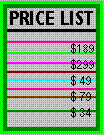Contact DEVELOPERS in Fleetrak's GPS Application Development Program.
The phone is ringing ! Your computerized equipment is calling you with an important message. When you pick up the phone, you hear the message from your equipment loud and clear - Thanks to the Stinger VCM (Voice Communications Module).
But that's not all. Need information from remotely operating equipment NOW ?. Easy - just pick up the phone and dial the Scorpion VCM. Ask for the information, status, or data you want. No, the VCM won't do speech recognition, but it is smart enough to react to touch-tones from the calling phone. You can boop - beep from your phone and the VCM responds to your tones with appropriate voice messages, including data. It's the next best thing to being at the equipment site to see what's happening.
REAL SPEECH - The Stinger VCM produces full quality natural speech. Nothing synthesized or robotic. It is as natural and authentic as the words you record directly into the non-volatile speech memory with the on-board microphone. Any language, or sounds with all the inflections and emphasis that you want. Simply specify non-volatile memory addresses to record your words, phrases, sentences and sounds, and start speaking. No WAV files to prepare or edit, No speech boards to add. No EPROM's to program. Simple, easy, and self-contained. (an attached PC is NOT required - this is a STAND-ALONE unit!!).
Just as easily as the Stinger VCM responds to your inquiries for data, the VCM can interpret and confirm your touch-tone commands to the connected equipment. This facility can be used to change set points, open and close valves, arm or dis-arm alarm systems, or whatever controls you decide to connect to it. It is just like having a remote control panel on your touch-tone phone. It's remarkably simple, inexpensive, and highly effective.
The Stinger VCM can add intelligent speech and control capability to just about any operating equipment with an ordinary serial port. You can create and manage a versatile voice and data channel with immediate access to operating equipment from any touch-tone phone - anywhere - anytime.
HARDWARE CAPABILITY - To enable this remote capability, The Stinger VCM contains non-volatile speech memory to store messages, a DTMF transceiver to dial out and interpret touch-tones from a calling phone, a DAA interface to standard telephone line, a serial port to interconnect with electronic equipment and a microprocessor to control the operation. The VCM unit and the connected computer equipment exchange information through a 3-wire RS232 channel. The connected system sends control codes, phone numbers and message addresses. Similarly, VCM sends touch-tone requests from the caller.
ON-BOARD INTELLIGENCE The Stinger VCM's embedded software provides a simple set of 13 single letter commands to handle telephone functions, control DTMF tones, and operate the storage and verbalization of messages. With these commands, you can choose the message or words, numbers to be spoken, interpret DTMF codes, change set points and alarm levels, and much more. For example, the V command initiates an outgoing call, dials a selected telephone number, and asks the answering party for a confirming DTMF tone - and then verbalizes the message that triggered the call.
EASY TALK Making the VCM unit talk, is easy too. Just send the starting memory location on the serial port, and the VCM will speak the entire recorded message. If you have stored the sentence: "Pump number 3 is operational" at address 62, the connected equipment would pass a data byte specifying location 62 to Stinger VCM, and the stored message would be spoken in the telephone call.
FLEXIBLE VOCABULARY You can construct the message
storage area with your choice of pre-recorded words, phrases, sentences,
and sounds, or string them together to form context-sensitive messages.
For example, in an industrial application, based on connected equipment
sensing the state of the relay that controls pump #3, it could send VCM
the appropriate memory address to say either:
"Pump number 3 is operational" or "Pump number 3 is NOT
operational".
NUMBERS AND TIME OF DAY You can also send voice
messages with just about any number, if you store the spoken numbers zero
through nine at separate addresses. The VCM unit can recite
them in the appropriate sequence, just like when you call the telephone
company for directory information, and hear: "the number is seven-three-five-nine-three-four-seven"
. The same technique can be used to report temperatures, voltages,
event counts, GPS coordinates, or just about any value that can be measured,
calculated, or counted. If you store the numbers "eleven and twelve" along
with "AM" and "PM", you could add the time of day information to your messages
based on querying a real-time-clock in the main system.
 |
PROTOTYPE STINGER VCM
"Temperature 72 degrees at 7:30 AM
|
CONTROL CAPABILITY In addition to managing and verbalizing messages, the VCM unit can change operating conditions such as set points and alarm levels of a connected system. Just dial the VCM from any touch-tone phone, and send your commands from the telephone's keypad. Immediate and convenient!. It's as if you were on-site, but without the travel time or expense.
INFORMATION AND CONTROL Staying in remote two-way contact with operating equipment has never been this easy. The Stinger VCM combines natural speech with touch-tone telephones to deliver context-sensitive messages automatically ... and to issue system commands for operational changes. It is all possible with the Stinger VCM - from any touch-tone phone, anytime, anywhere.
REMOTE TELEMETRY - VEHICLE TRACKING WITH GPS Due to the flexibility of the Stinger VCM, it is possible to establish real - time vehicle tracking and control, when the unit is connected to a GPS-equipped TC-01 microcontroller and a cellular telephone equipped with a DAA interface (RJ-11 jack). In this scenario, the controller's firmware would monitor the vehicle's route, speed, and course. With GPS data being fed to the unit by any standard GPS equipment - be it a GPS receiver card, or NMEA-compatible receiver engine, the controller could keep the vehicle on course by speaking directions to the driver. Coupled with an S-RAM card for the route assignment, the driver would not need to know the planned route at all. This process would keep this information confidential until the very last moment. Tied in to the vehicle's door locks, ignition system, horn, sirens and lights, the system could be made to prompt the driver along a route that he has no idea where it will lead. If the vehicle strays from the route, the attached controller could be made to initiate a series of security measures to prevent the truck from being hijacked - for instance, if the driver were to make a left turn when instructed to turn right, the system could lock the doors and disable the door mechanism. A warning would then be spoken for the driver to correct his course. Simultaneously, a cell phone call would be initiated to the dispatcher, and a log made of the time and place where the violation occurred. Within a preset time limit, the driver must correct the course, or the vehicle would be disabled: i.e. brakes gently applied, and ignition cut off. The police could then also be notified that an attempt was made to take the cargo, and since the occupants are locked inside, a special code must be sent by calling the truck on the phone, and initiating a DTMF sequence to unlock the doors.
Far less dramatic, but just as promising an application would be an inexpensive system for keeping automated driver logs for the trucking industry. A route prompt could be built into the system as above, but without the disabling features that would allow the driver to negotiate around traffic, or take a familiar route to his favorite rest stop. At preset times, the Stinger VCM could initiate a call to a dispatcher, and SPEAK the truck's whereabouts, and statistical information such as average and top speed, how long the truck has been in motion, how and where it stopped, and the temperature and status of refrigeration etc. This data could also be logged to S-RAM cards, to turn in to the dispatcher at the end of the run. With this data, the truck's practice course could be plotted on a map, and any discrepancies such as speeding, driving too long continuously without a break, making unauthorized stops, unauthorized opening of cargo doors - anything that can be sensed, measured, or counted, can be included both in the data record, and in the initiated call to the dispatcher.


